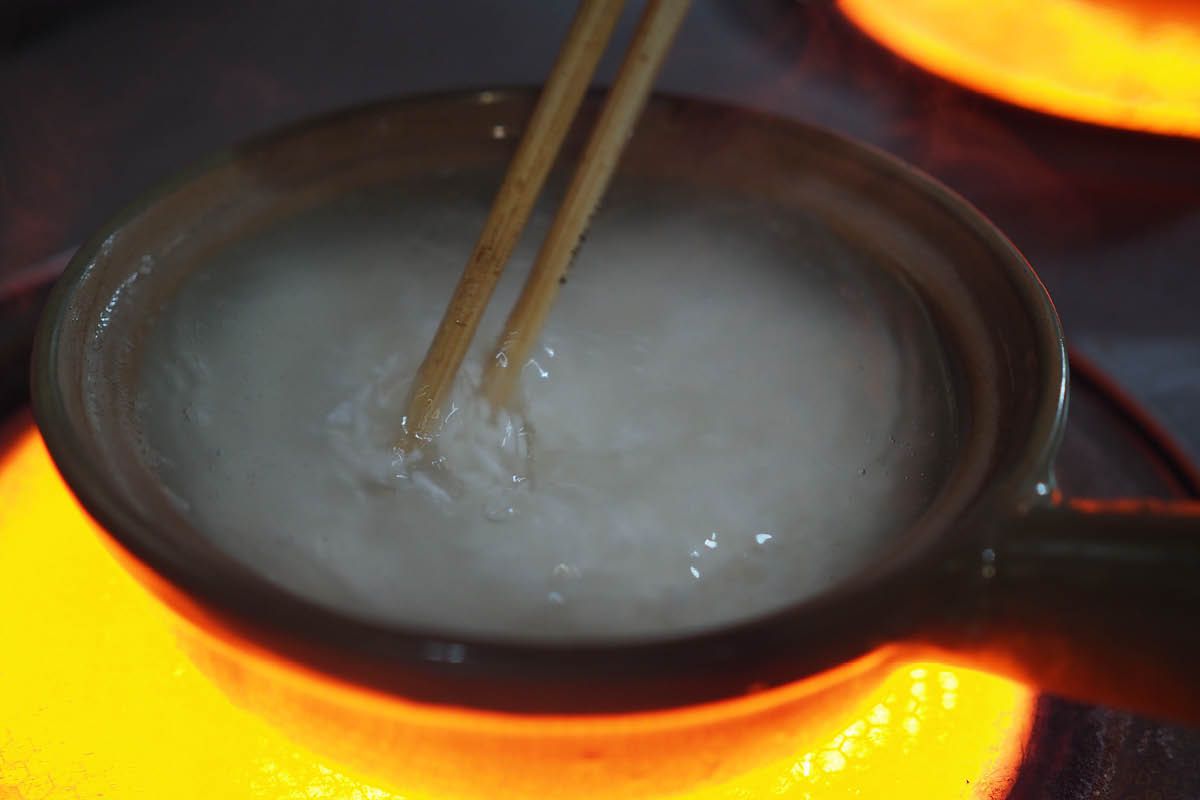“Back then, claypot rice was cooked over charcoal stoves. The rice bubbled and steamed inside the claypot. The fragrance and taste were incredible…” Chef-owner Lam Weng Hong of Kennedy Town’s Sheung Hei Claypot Rice takes us back to more than three decades ago, as he recounts his fond childhood memories of being inside the kitchen of the famed Kwan Kee Clay Pot Rice in Sai Wan. That year, he was still in primary school.
Claypot rice is a soul-restoring dish unique to Cantonese cuisine. Known as bo zai faan in Cantonese, raw rice is cooked to fluffy perfection inside the claypot (bo zai). It rose to popularity in the 1980s, and became one of the three major folk delicacies alongside rice noodle rolls (cheong fun) and freshly boiled congee (sang gwun juk). In the past, restaurants would set up charcoal stoves streetside to attract customers. The row of around a dozen claypots set the stage for the chef’s culinary performance in enticing the senses of passers-by.

Back then, the Sai Wan area would come alive during the colder seasons. Around 6pm, local residents old and young would sit around tables put up in the open space outside the restaurant, popping open beers and enjoying a few dishes and claypot rice. “The dishes included stir-fried kale stems and Chinese cured meat; for claypot rice, we had toppings like Chinese sausage, eel, and even Chinese preserved duck and frogs… the atmosphere of the entire community was great,” Lam shares his memories in vivid detail. At that time he lived right above Kwan Kee restaurant. He was very curious and chatted often with the chefs, which ignited his love of cooking. The captivating scent of charcoal and the comfort of human warmth made these scenes from his childhood all the more memorable.


However, as the Hong Kong government tightens safety regulations around the use of charcoal as fuel at licensed food premises in recent years, such authentic way of making claypot rice has become a rare sight. Sheung Hei Claypot Rice almost closed down for this very reason. “I remember very clearly that it was eight years ago, just before Chinese New Year, when FEHD initiated prosecution against us.” Feeling dejected, Lam went to relax at a sauna in Kowloon. It was there that he saw the shop heating water with lava rocks, and he found a solution: he could replace charcoal with lava rocks.
RELATED: Cantonese Pastries & Cakes: MICHELIN-Starred Chinese Chefs’ Sweet Childhood Memories



Not being afraid to break some rules and innovate is Lam’s motto. Even though there’s a set of golden rules on how to make delicious claypot rice, he believes that there are still lots of details worth considering, such as the cooking utensils. Lam thinks that ceramic claypots are more durable than traditional claypots, and can create rice crusts that are beautifully golden and crispier, and can be easily scooped out with a spoon. Claypot rice doesn’t always have to go with stir-fried dishes, and can be paired with dim sum in steamer baskets for an easy lunch. “We can enjoy claypot rice anytime, not just in autumn!” Lam says that chefs can adjust the heat and cooking technique in different seasons, such as making a thinner rice crust in summer and a thicker one in winter; the toppings can be different too based on the ingredients’ aroma and texture, so diners can enjoy the essence of seasonal Cantonese dining even with claypot rice.


Serving claypot rice during lunch means that the chef must control the cooking time perfectly so customers don’t have to wait for too long. Currently, the custom-made Japanese lava rock grill can cook one serving of rice in 20 minutes. ”My record is making more than 300 servings in a single evening!” Lam is very hands-on with selecting ingredients. He uses Golden Camel jasmine rice, Chinese cured meat and salted fish Lam Kiu Kee—his family business that specialises in dried seafood—and eel from Tak Kee at the nearby Smithfield Market; he often works in the kitchen and makes the claypot rice himself. Today, Lam is busy with all the dine-in lunch orders, making over ten portions at the same time. Within a minute, small beads of sweat trickle down his nose and forehead, but this didn’t slow him down. He remains focused and energised, keeping an eye on all the claypots.


Savouring claypot rice is a simple pleasure. This is how Lam describes it: “It’s the perfect marriage of the sweet rice fragrance and the oily aroma of the toppings. You don’t need to spend much, but it’s a dish that can warm your soul in the cold of winter.” Even after the termination of a partnership and the hardships brought on by the pandemic, this dish has remained the same for him. Now that we’re seeing some light at the end of the pandemic’s tunnel, Lam hopes to connect the world through claypot rice. “Just like burgers, claypot rice can be adapted with ingredients from different countries and cultures, so diners may be hit with a wave of nostalgia when they enjoy the dish.”
Text and photos by 孔牧, translated by Iris Wong. Read original article here.






















